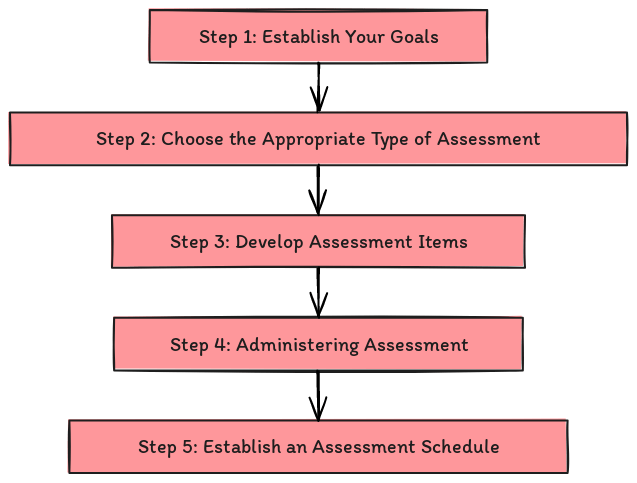Formative assessment is a continuous process both educators and learners employ to enhance teaching and learning experiences. By monitoring learners’ progress and providing feedback, formative assessment supports self-directed learning and helps learners achieve disciplinary learning outcomes. This article discusses the significance of formative assessment in outcomes assessment plans for apprenticeship programmes, its benefits, and a five-step approach to creating an effective outcomes assessment plan.
Understanding Formative Assessment
What is Formative Assessment?
Formative assessment is an ongoing process by educators and learners to improve teaching and learning practices. Unlike summative assessments, which evaluate learner performance at the end of an instructional period, formative assessments are conducted throughout the learning process. This approach enables learners to comprehend the disciplinary learning outcomes they are working towards while enabling self-directed learning. The primary objective of formative assessment is to monitor learning progression and offer feedback, enabling learners to enhance their understanding.
Key Characteristics of Formative Assessment
- Continuous Process: Formative assessment is not a one-time event but a continuous process during the learning.
- Feedback-Oriented: The core of formative assessment is providing feedback that helps learners understand their progress and identify areas for improvement.
- Learner-Centered: It focuses on the needs of the learners, encouraging them to take an active role in their learning process.
- Adaptive: It allows educators to adapt their teaching strategies based on the ongoing learner needs assessment.
Benefits of Formative Assessment
- Improved Learning Outcomes: Regular feedback helps learners understand their strengths and weaknesses, leading to better learning outcomes.
- Enhanced Engagement: Learners are more engaged when they receive continuous feedback and feel supported in their learning.
- Informed Instruction: Educators can adjust their teaching methods to suit the needs of their learners better, leading to more effective instruction.
Formative Assessment in Apprenticeship Programmes
The Role of Formative Assessment in Apprenticeships
In addition to its application in traditional educational settings, formative assessment is paramount in outcomes assessment plans for apprenticeship programmes. By ensuring the apprenticeship programme aligns with the needs of both learners and employers, formative assessment enhances the overall quality of apprenticeships and benefits all stakeholders.
Benefits for Apprentices
- Clear Understanding of Objectives: Apprentices understand the skills and knowledge they need to acquire.
- Self-Directed Learning: Continuous feedback encourages apprentices to take charge of their learning and make necessary adjustments.
- Skill Mastery: Apprentices can identify areas to improve and focus on mastering the necessary skills.
Benefits for Employers
- Workforce Preparedness: Employers can be confident that apprentices are acquiring the necessary skills and knowledge.
- Customised Training: Feedback from formative assessments can be used to tailor training to meet specific industry needs.
- Enhanced Productivity: Well-trained apprentices contribute more effectively to the workplace.
Benefits for Educators
- Instructional Improvement: Educators receive feedback on their teaching methods, allowing them to make necessary adjustments.
- Focused Support: Educators can identify areas where learners need additional support and provide targeted assistance.
- Program Quality: Continuous assessment ensures that the apprenticeship programme maintains high standards and meets learning objectives.
Formative Outcomes Assessment Planning
Utilising Formative Assessment in Outcomes Assessment Planning
Formative assessment is a valuable tool in designing and delivering successful apprenticeship programmes. When employed formatively, assessment can:
- Enable Learners to Comprehend Their Learning Objectives: Learners can identify areas of misunderstanding and work towards achieving their goals.
- Support Educators in Refining Instructional Techniques: Educators can enhance their teaching strategies by pinpointing areas for improvement.
- Provide Feedback to Apprenticeship Coordinators: Ensuring the programme meets learners’ and employers’ needs.
Steps to Creating an Effective Outcomes Assessment Plan
Step 1: Establish Your Goals

Begin by outlining your assessment goals. Determine the insights you wish to gain from the assessment and the information required to enhance teaching and learning practices. Clear goals provide direction and focus for your assessment plan.
Step 2: Choose the Appropriate Type of Assessment
After identifying your goals, select a suitable assessment type to provide the necessary information. Various formative assessments include quizzes, peer assessments, self-assessments, and observational assessments. Choosing the one that aligns with your objectives is essential.
Step 3: Develop Assessment Items
Following selecting an assessment type, create items for the assessment. These items should evaluate the skills and knowledge targeted in the assessment. For formative assessment items, consider the following aspects:
- Alignment with Learning Objectives: Ensure the assessment items are directly related to the learning objectives.
- Developmental Appropriateness: The items should be suitable for the learners’ developmental stage.
- Challenge Level: The items should be challenging but not overly difficult to encourage growth without causing frustration.
- Learner Engagement: Design engaging and relevant assessment items to maintain learner interest.
Various resources can be found online to aid in developing formative assessment items.
Step 4: Administering Assessment
Next, decide on an administration method for the assessment. Consider whether it will be conducted in person, online, or using a paper-and-pencil format. Each method has pros and cons, so select the one that best suits your needs. For instance, online assessments offer immediate feedback, while in-person assessments might provide a more personal touch.
Step 5: Establish an Assessment Schedule
Lastly, establish a schedule for formative assessments. Create this schedule in advance to ensure regular and consistent formative assessments. A well-planned schedule helps maintain the momentum of continuous assessment and ensures timely feedback.
Implementing Formative Assessment in Apprenticeship Programmes
Strategies for Effective Implementation
Implementing formative assessment in apprenticeship programmes requires careful planning and execution. Here are some strategies to ensure effective implementation:
Involve Stakeholders
Engage all stakeholders in the assessment process, including learners, educators, and employers. Their input can provide valuable insights and help tailor the assessment to meet everyone’s needs.
Provide Training
Ensure that educators and mentors are well-trained in formative assessment techniques. Provide professional development opportunities to help them understand and effectively implement formative assessments.
Use Technology
Use technology to streamline the assessment process. Online platforms can facilitate the administration of assessments, provide instant feedback, and track learner progress over time.
Create a Feedback Loop
Establish a robust feedback loop where learners receive timely feedback, reflect on it, and take necessary actions. Encourage learners to ask questions and seek clarification to enhance their understanding.
Examples of Formative Assessment Techniques
- Quizzes: Short, frequent quizzes can help monitor learner progress and identify areas for improvement.
- Peer Assessments: Learners assess each other’s work, providing valuable feedback and promoting collaborative learning.
- Self-Assessments: Learners reflect on their performance, identify strengths and weaknesses, and set personal goals.
- Observational Assessments: Educators observe learners in action and provide immediate feedback on their performance.
Overcoming Challenges in Formative Assessment
Common Challenges
Implementing formative assessment can present several challenges, including:
- Resistance to Change: Both educators and learners might resist adopting new assessment methods.
- Time Constraints: Continuous assessment requires time and effort, which can be challenging in already busy schedules.
- Consistency: Ensuring consistent application of formative assessment techniques across different educators and settings.
Strategies to Address Challenges
- Promote a Culture of Continuous Improvement: Encourage a culture that values continuous learning and improvement among educators and learners.
- Provide Resources and Support: Offer resources, such as training sessions and assessment tools, to help educators implement formative assessments.
- Streamline Processes: Use technology to streamline the assessment process and reduce the administrative burden on educators.
- Encourage Collaboration: Promote collaboration among educators to share best practices and support each other in implementing formative assessments.
Case Studies and Real-World Applications
Case Study 1: Apprenticeship Programme in Manufacturing
In a manufacturing apprenticeship programme, formative assessments were integrated into the training process. Apprentices received regular feedback on their performance through quizzes, peer assessments, and observational assessments. This approach led to improved skill acquisition, higher learner engagement, and better alignment with industry needs.
Case Study 2: Healthcare Apprenticeship Programme
A healthcare apprenticeship programme implemented formative assessments to monitor the progress of apprentices. By using self-assessments and peer assessments, apprentices gained a deeper understanding of their learning objectives and received constructive feedback. This resulted in enhanced clinical skills and better preparedness for the workforce.
Lessons Learned
- Engage Stakeholders Early: Involving all stakeholders from the beginning ensures that the assessment process is relevant and valuable.
- Provide Continuous Support: Ongoing support and training for educators and learners are essential for successful implementation.
- Use Data to Inform Decisions: Regularly review assessment data to make informed decisions and improve the apprenticeship programme.
Conclusion
Formative assessment is a powerful tool that aids in creating successful apprenticeship programmes. By integrating formative assessment, all participants in the programme can benefit from the experience. Learners gain a clearer understanding of their objectives, receive continuous feedback, and engage in self-directed learning. Educators can refine their instructional methods, and employers benefit from a well-prepared workforce.
As educational practices continue to evolve, the role of formative assessment will become increasingly important. Embracing innovative assessment techniques and utilising technology will further enhance the effectiveness of formative assessments. By staying committed to continuous improvement, educators, learners, and employers can ensure that apprenticeship programmes remain relevant, effective, and beneficial for all stakeholders.



